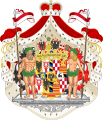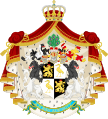Coat of arms of Thuringia
| Coat of arms of Thuringia | ||
|---|---|---|
Shield | Azure, a lion rampant barry of eight Gules and Argent, crowned and armed Or, surrounded by eight mullets Argent | |
The
Description
The coat of arms can be blazoned Azure, a lion rampant barry of eight Gules and Argent, crowned and armed Or, surrounded by eight mullets Argent.[1] This can be interpreted as a blue field with a lion of eight horizontal red-and-white-stripes, with a gold crown and claws, with eight white/silver stars. Some people believe the stars represent eight historical divisions of the state.[1]
Legal position
It was included in the Gesetz über die Hoheitszeichen (Law on the Regional Emblems) of 30 January 1991,[2] which came into law retrospectively to 3 October 1990.[2] The current law, Verordnung zur Ausführung des Gesetzes über die Hoheitszeichen des Landes prescribed its use, including banning use by third parties,[3] use of the coat of arms on the seal[3] and use of the arms on the State flag.[3]
History
Gallery
-
Schwarzburg-Sondershausen 1599-1918
-
Schwarzburg-Rudolstadt 1599–1918
-
Duchy of Saxe-Altenburg 1602–1672 and 1826-1918
-
Duchy of Saxe-Meiningen 1680–1918
-
Duchy of Saxe-Gotha-Altenburg 1672–1826
-
Duchy of Saxe-Hildburghausen 1680–1826
-
Principality of Reuss-Greiz 1778–1918
-
Principality of Reuss-Gera 1806–1918
-
Saxe-Weimar-Eisenach 1809–1918
-
Saxe-Coburg and Gotha 1826–1918
-
People's State of Reuss 1919–1920
-
Free State of Thuringia 1921-1933
-
Free State of Thuringia 1933-1945
-
Coat of arms of Thuringia 1945–1952
State of Thuringia (1920 - 1933)
The state of Thuringia was created in 1920 by uniting the seven Thuringian polities:
Landgraves of Thuringia

In 1040 the
The arms, used by Landgrave Conrad in the 13th century, were azure, a crowned lion rampant barry of eight argent and gules, crown and claws or.[citation needed]
References
- ^ a b "Thuringia (Germany) - Coat of arms". Flags of the World. 7 Oct 2001. Retrieved 2009-04-26.
- ^ a b Gesetz über die Hoheitszeichen des Landes Thüringen Archived 2009-11-03 at the Wayback Machine (Law on the regional emblems of the Land of Thuringia). Accessed 2009-04-26. (in German)
- ^ a b c Verordnung zur Ausführung des Gesetzes über die Hoheitszeichen des Landes Archived 2011-07-19 at the Wayback Machine (Regulation for the implementation of the law on the regional emblem of the state). Accessed 2009-04-26. (in German)
- ^ a b State of Thuringia at Flags of the World Accessed 2009-05-16.
See also
- Coat of arms of Prussia
- Coat of arms of Germany
- Coat of arms of Hesse, which has a similar appearance.
- Origin of the coats of arms of German federal states.













